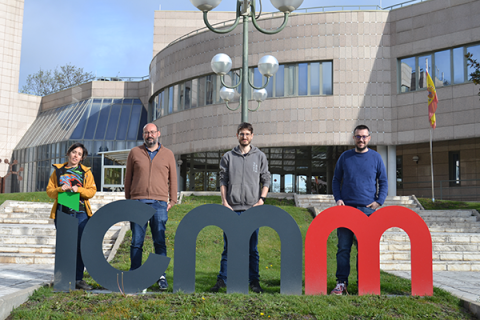Four ICMM-CSIC researchers get Ramón y Cajal contracts

Four researchers who have developed their scientific careers at the Material Science Institute of Madrid (ICMM-CSIC) have got Ramón y Cajal contracts, aimed at research personnel with "an outstanding career", explains the Spanish Agency for Research in its call. The four researchers are: Eider Berganza, Rui E. Silva, José Carlos García-Abadillo Uriel and Javier Pérez Carvajal, and each one will develop their own research lines.
Eider Berganza has already started her Ramón y Cajal Contract. During five years, she plans to follow two distinct research lines: the fundamental study of 3-dimensional and curvature-induced effects in nanomagnetic structures and the functionalization of 3D magnetic microstructures, "a follow-up of my postdoctoral period research line, aiming at finding new routes to endow additional functionalities", explains the researcher.
"One of the aims of magnetic nanostructure engineering is the manipulation of stray fields and magnetic confinement through the design of geometrical effects", says the scientist. She adds that "while shaping 2D magnetic nanostructures in different shapes has been long exploited, the study nanostructures with 3-dimensional shape, which are of high technological interest, remains still highly unexplored". Besides, Berganza says that the emergence of new 3D printing technologies "holds promise to start a new technological era through the incorporation of complexed-shaped multifunctional microrobots", and that's why she wants to explore this area: "In particular, magnetic field responsive structures possess interesting advantages in comparison to microstructures that react to other physical and chemical stimuli, such as the possibility for remote control".
Javier Pérez Carvajal will start his contract in June. He has developed research in material science related to the synthesis and characterization of inorganic nanoparticles, clays, 2D solids, their heterostructures and composites, including also Metal-Organic framework (MOFs) and Covalent Organic Framework (COFs) synthesized under typical conditions and under eco-friendly and sustainable conditions. From this summer, he will develop a research line entitled 'Sustainable MOF and COF heterostructures for environmental remediation and energy conversion'.
"This research line is focused on the preparation of different heterostructured materials in which different metal-organic structures, MOF, are grown on natural clays to give rise to materials that we will identify as MOF@clay", explains the researcher. He says that that kind of nanoarchitecture "is expected to present the high performance of the MOF while the clay provides processability". "This ongoing section of the research line is an approach to these prompting new type of advanced materials from sustainability merging the use of natural products as construction units of the framework and their future use as in solar technology, among others", adds Carvajal.
José Carlos García-Abadillo Uriel, who is now developing a research project thanks to a Com-Futuro distinction, will start his contract in September. "My main research line is focused on quantum computing with solid-state systems, especially with semiconductors", explains the researcher. The idea is to develop new quantum hardware based on the same semiconductor technology that is already used in laptops or smartphones. "This has a great advantage as the same industrial processes already established in classical computing could be adapted to quantum computing", says García-Abadillo.
"This would allow efficient quantum computing, based on electric fields, and with great potential for scalability", continues the scientist. "When it comes to entanglement and scaling the number of qubits, I have a great interest in hybrid quantum systems, which can be used to connect semiconductor qubits with each other and/or with superconducting qubits, for example, through the photons of a cavity or through the proximity effect". "These hybrid systems would allow a quantum computer to be scaled, taking advantage of the advantages of different technologies," he concludes.
Rui E. F. Silva will start his contract in September. He has been working in the field of attosecond physics in solids and he is currently a LaCaixa Junior Leader fellow. His main focus is the understanding of the ultrafast dynamics of electrons in solids when illuminated by strong and intense laser field. For the Ramon y Cajal contract, he will start a project entitled 'Attosecond phenomena in 2D materials'.
"The use of intense ultrafast laser pulses in solids provides a perfect tool to track, control and change electronic dynamics in condensed phases at the femtosecond (1fs=10^-15 s) to attosecond (1as=10^-18 s) timescale", explains the researcher. The understanding of how to use light fields to control electronic motion in solids on these timescales "is essential for paving the way to perform electronics at optical frequencies (petahertz electronics) and to explore the valley degree of freedom for electronics (valleytronics) at femtosecond time-scale, taking full advantage of electronic coherence," he points out. "This project focuses on the control of electronic motion, therefore controlling the material properties, by shaping electric field of electromagnetic (EM) wave within each cycle.", concludes Silva.
ICMMSor Juana Ines de la Cruz, 3 |  |
Contacto | Accesibilidad | Aviso legal | Política de Cookies | Protección de datos

